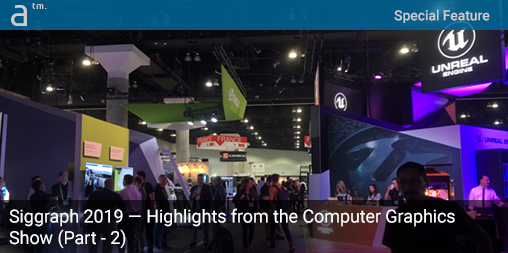SIGGRAPH 2019 is behind us but not without leaving artists, creators, technology enthusiasts without a lot to think about. Every type of hardware was at SIGGRAPH from Dell workstations to iMac Pros and laptops. It was a diverse group with a strong focus on the future of Open Source.
Open Source is Thriving
Open Source was the featured topic. Open Source is thriving in development in all aspects of the pipeline in 3D software industries.

JPR Luncheon session had industry leaders talking about the revolutionary effect of open source in the pipeline.
The JPR Luncheon featured “The revolutionary effect of open source software for creative applications”. This was an interesting topic with great experts on the subject including Hank Driskill from Blue Sky Studios, Daniella Costa VP of Visual Effects of Marvel Studios, John Wadelton, CTO of the Foundry and Guy Martin, Director of Open Source Strategy for Autodesk.

A shot of the Blender booth prior during a quiet moment on the expo floor Ton Roosendaal received a special award for his software Blender during the luncheon.
The discussion was focused on the future of open source in the pipeline and how it would benefit creatives and give them more flexibility. USD was mentioned due to being implemented in so many pipelines now and the huge benefits. Ton Roosendaal received a special award at the luncheon for his wonderful software Blender.
Universal Scene Description — A New Emerging Standard
USD stands for Universal Scene Description and it was created by Pixar. In 2015 Pixar announced that they would make their Universal Scene Description Open Source. USD was first presented at SIGGRAPH 2013. USD provides a standard for exchanging complex Animation and VFX scene data.
There is also an embeddable visualization to the Hydra renderer. USD goes further than Alembic by describing the structure of the entire scene not just individual assets. It supports layering, file referencing, geometry and sharing variants for each asset in the scene and inheritance. Each of the cooperating applications in the pipeline including modeling, shading, animation, lighting and FX can now be assembled into another applications in a nondestructive form with a single consistent API. This means less baking down of your data. This gives the industry a standard to ease the headache of importing, translation, and exporting. It allows creatives in different areas of the pipeline to collaborate on the same scenes without having to wait for one person to finish.
Autodesk announced support of USD at this year’s SIGGRAPH. NVIDIA is using USD for the foundation of Omniverse, a live collaboration platform that connects a wide variety of content creations tools to each other and to the real time RTX engine; The Foundry, Unity, Epic Games (Unreal Engine), Pixar, Animal Logic are already developing uses for USD in their applications.
Open XR, is another cool open source technology from the Khronos Group that is setting a new standard for Virtual Reality and Augmented Reality application developers to help streamline their pipelines from going from one SDK to another. Open XR allows games and other applications to work easily across a variety of platforms without dealing with proprietary SDK’s. AMD, NVIDIA, Valve, Microsoft, Epic Games Unity, LG, Samsung, Sony, Varjo, Nokia, and Google are among industry supporters. Open XR Application Interface is available now and Open XR Device Plug in interface is coming soon.
This gives the industry a standard to ease the headache of importing, translation, and exporting. It allows creatives in different areas of the pipeline to collaborate on the same scenes without having to wait for one person to finish.
NVIDIA RTX is a graphics rendering development platform enabling real time ray tracing. It is now a popular platform for developers of games, 3D applications, and VR/AR. In the past ray tracing was only found in non-real time applications. Video games had to rely on rasterization for their rendering. RTX made it development easier by generating interactive images that react to lighting, shadows and reflections. RTX runs on the NVIDIA Volta and Turing based GPU’s. specifically utilizing the Tensor Cores (new RT cores on Turing) on the architecture for ray tracing acceleration. NVIDIA announced in March 2019 that selected GTX -10 series (Pascal) and GTX 16 series (Turing) cards would receive subset of RTX Technology in upcoming drivers though ray tracing would be affected by lack of dedicated hardware cores.
next page: The future of Max, OTOY, game engines, RenderMan and more…







Reader Comments
Comments for this story are closed